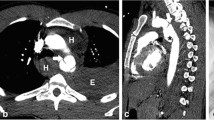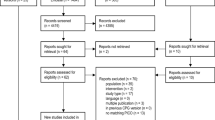Abstract
Purpose
Pneumomediastinum is the hallmark of intrathoracic aerodigestive trauma, but rare following blunt injury. Aim: review of blunt thoracic trauma (BTC) for the incidence and outcome of patients with pneumomediastinum or pneumopericardium (PM/PC) on Computerised Tomographic scanning.
Methods
Admissions to the level I trauma ICU at IALCH, Durban, ZA following BTC from April 2007 to March 2014. Patients with Chest-CT-scan were analysed. Variables included age, sex, mechanism of injury, and Injury Severity Score (ISS). Specific injury patterns: isolated thoracic trauma, flail chest, bilateral injury and presence of haemothorax or pneumothorax were analysed.
Results
Three hundred and eighty-nine patients were included. Males (70.9%) accounted for the majority of patients. The median Injury Severity Score was 32 (IQR 24-41). Motor vehicle collisions accounted for 94% of injury mechanisms. Twenty-three (5.9%) were identified with pneumomediastinum, 6 (1.5%) with both pneumomediastinum and pneumopericardium, and 1 (0.2%) with isolated pneumopericardium. No patient required surgery for thoracic trauma. Increasing age (p < 0.001) and a flail chest (p = 0.005) were significant associations. The mortality rate was almost identical in those with or without air within the mediastinum. No patient died from a missed mediastinal aero-digestive injury.
Conclusion
The presence of PM/PC following BTC is incidental and benign. Increased injury severity with a flail chest is associated with a significant increase in the presence of free gas within the mediastinum. In the absence of complications, no obvious injury to the intrathoracic aero-digestive tract on CT scanning, and no difference in mortality, a conservative management policy is warranted.



Similar content being viewed by others
References
Zylak CM, Standen JR, Barnes GR, Zylak CJ. Pneumomediastinum revisited. Radiographics. 2000;20:1043–57.
Dissanaike S, Shalhub S, Jurkovitch GJ. The evaluation of pneumomediastinum in blunt trauma patients. J Trauma. 2008;65:1340–5.
Ganie FA, Lone HU, Singh S, et al. Traumatic pneumomediastinum: a risk factor for the development of pneumopericardium. Int J Stud Res. 2013;3:7–10.
Chouliaris K, Bench E, Talving P, et al. Pneumomediastinum following blunt trauma: worth an exhaustive workup? J Trauma Acute Care Surg. 2015;79:188–93.
Lee WS, Chong VE, Victorino GP. Computed tomographic findings and mortality in patients with pneumomediastinum from blunt trauma. JAMA Surg. 2015. https://doi.org/10.1001/jamasurg.2015.1138. Published online June 24.
von Bergen V, Dissanaike S, Jurkovitch GJ. Pneumomediastinum in blunt trauma: a review. Trauma. 2011;13:199–211.
Cedeno A, Echeverria K, Vazquez J, et al. Intrathoracic oesophageal rupture distal to the carina after blunt chest trauma: case report. Int J Surg Case Rep. 2015;16:184–6.
Macklin C. Transport of air along sheaths of pulmonic blood vessels from alveoli to mediastinum: clinical implication. Arch Int Med. 1939;64:913 – 26.
Madden BP. Evolutional trends in the management of tracheal and bronchial injuries. J Thoracic Dis. 2017;9:E67-70.
Makhani M, Midani D, Goldberg A, Friedenberg FK. Pathogenesis and outcomes of traumatic injuries of the esophagus. Dis Esophagus. 2014;27:630–6.
Kuhne CA, Kaiser GM, Flohe S, et al. Nonoperative management of tracheobronchial injuries in severely injured patients. Surg Today. 2005;35:518–23.
Wintermark M, Schnyder P. The Macklin effect. A frequent etiology for pneumomediastinum in severe blunt chest trauma. Chest. 2001;120:543–7.
Oikonomou A, Prassopoulos P. CT imaging of blunt chest trauma. Insights Imaging. 2011;2:281–95.
Mansella G, Bingisser R, Nickel CH. Pneumomediastinum in blunt chest trauma: a case report and review of the literature. Case Rep Emerg Med. 2014. https://doi.org/10.1155/2014/685381.
Agarwal PP. The ring-around-the-artery sign. Radiology. 2006;241:943–4.
Marques AFR, LopeS LH, Martins LS, et al. Tension pneumopericardium in blunt chest trauma. Int J Surg Case Reports. 2016;24:188–90.
Author information
Authors and Affiliations
Corresponding author
Ethics declarations
Conflict of interest
No conflict of interest reported for any of the authors.
Rights and permissions
About this article
Cite this article
Muckart, D.J.J., Hardcastle, T.C. & Skinner, D.L. Pneumomediastinum and pneumopericardium following blunt thoracic trauma: much ado about nothing?. Eur J Trauma Emerg Surg 45, 927–931 (2019). https://doi.org/10.1007/s00068-018-0960-5
Received:
Accepted:
Published:
Issue Date:
DOI: https://doi.org/10.1007/s00068-018-0960-5




